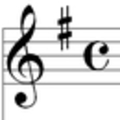Sign In
CloseExercise 15 (c) by Irbis (critique requested)

This is the third (and final, I'm not doing the massive chord table Tchaikovsky suggests) exercise of Chapter 2 of the Guide to the Practical Study of Harmony by Peter Ilyitch Tchaikovsky.
Submission Information
- Views:
- 473
- Comments:
- 6
- Favorites:
- 1
- Rating:
- General
- Category:
- Multimedia / Other
Comments
-
-

Well, it depends on each exercise really. In this case, Tchaikovsky gave the Bass and asks the reader to supply the Soprano, Alto, and Tenor. At this point, every chord is to share common tones with the subsequent chord, the Alto and Tenor are to be kept as close as possible to the Soprano, no diminished chords are permitted, and the upper voices are not to go too high away from the Bass.
-

Based on this response, my right-now critique would be:
I think the soprano generally carries the melody. This melody doesn't seem very free, more like an afterthought from the harmonies you were trying to make. To me it feels like it's the other way around. Not sure if that's actually how you approached it. But for instance, the soprano spends several bars on one note a few times. It's not as musically exciting, compared to a fully-formed melody (obviously). Not a flaw per-se! It's an exercise, after all.
So the bass line suggests a harmony, in pretty much every composition. My approach might be to base the soprano/melody around the bass's suggested harmony. Then once the melody is there, I'd fill in the tenor and alto voices, which fill in the actual harmony, in accordance with the constraints given by the rules/style/etc. This, I think, generally supports the melody well, and would probably tend to make the exercises sound more musical, which probably makes for keener practice and faster learning.
I hope this is useful feedback.
-

It is handy, though while working through this book the melody will always remain a secondary concern, being a lesson in harmony, after all. :) Especially at this early point, where suspensions, anticipations, passing and changing notes, chord inversions, free voice-leading, 7th chords, key modulations etc. are all 'out of scope' and not to be used. I'm deliberately limiting myself to those forms, figurations, and concepts that Tchaikovsky has actually discussed in completing the exercises. There's terribly little at this point!
That said, I certainly would want a more interesting melody than what the Soprano has here. Some nice suspensions, some melodic digressions from the harmony, etc. could make for a very pretty piece! In fact, from a harmonic standpoint, the lack of a well prepared V7-I cadence at the end makes this piece rather unsatisfying.
-
-
-



Link
kerplunk
I think I'm going to find this book and try working thorugh it at some point. It has a great name attached to it. :3
Says here you're looking for critique... what kind of critique are you looking for? Seems easier to critique if I had worked through this already...